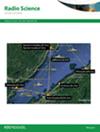Comparison and validation of 212.5 MHz Gauhati university stratosphere troposphere radar data with reference to radiosonde observation
IF 1.5
4区 地球科学
Q3 ASTRONOMY & ASTROPHYSICS
引用次数: 0
Abstract
A novel Stratosphere-Troposphere (ST) Radar at 212.5 MHz is installed at Gauhati University (GU), Guwahati (26.15°N, 91.66°E), India with the objective to study wind pattern over the region. This paper presents first time validation of this wind profiler data from 300 m to 15 km altitude in comparison with collocated GPS Radiosonde measurements. The radar wind data match very well with radiosonde observations both in magnitude and directions. The correlation coefficient for zonal and meridional winds are found to be 0.94 and 0.95, respectively. The standard deviation of difference between radar and radiosonde data for zonal and meridional wind is 1.87 and 1.90 ms−1, respectively. The ST radar data are further classified as precipitation and non-precipitation cases and compared to radiosonde data. For precipitation cases the correlation coefficients of zonal and meridional wind are found to be 0.94 and 0.94, respectively, whereas the correlation coefficients for zonal and meridional wind in non-precipitation cases are 0.93 and 0.96, respectively. Besides, vertical wind is validated by analyzing its performance during precipitation event. These results align with other operational wind profiler radars, establishing the GU ST Radar as a reliable tool for providing high quality wind data.高哈蒂大学212.5 MHz平流层对流层雷达资料与探空观测资料的比较与验证
在印度高哈蒂大学(GU)(26.15°N, 91.66°E)安装了一台212.5 MHz的新型平流层对流层雷达,目的是研究该地区的风型。本文首次对300米至15公里高度的风廓线数据进行了验证,并与GPS无线电探空仪的测量结果进行了比较。雷达风资料在大小和方向上都与无线电探空观测结果吻合得很好。纬向风和经向风的相关系数分别为0.94和0.95。雷达和探空资料对纬向风和经向风的差值标准差分别为1.87和1.90 ms−1。ST雷达数据进一步分为降水和非降水情况,并与探空数据进行比较。降水条件下纬向风和经向风的相关系数分别为0.94和0.94,非降水条件下纬向风和经向风的相关系数分别为0.93和0.96。此外,通过分析垂直风在降水过程中的表现,验证了垂直风的有效性。这些结果与其他操作风廓线雷达一致,使GU ST雷达成为提供高质量风数据的可靠工具。
本文章由计算机程序翻译,如有差异,请以英文原文为准。
求助全文
约1分钟内获得全文
求助全文
来源期刊

Radio Science
工程技术-地球化学与地球物理
CiteScore
3.30
自引率
12.50%
发文量
112
审稿时长
1 months
期刊介绍:
Radio Science (RDS) publishes original scientific contributions on radio-frequency electromagnetic-propagation and its applications. Contributions covering measurement, modelling, prediction and forecasting techniques pertinent to fields and waves - including antennas, signals and systems, the terrestrial and space environment and radio propagation problems in radio astronomy - are welcome. Contributions may address propagation through, interaction with, and remote sensing of structures, geophysical media, plasmas, and materials, as well as the application of radio frequency electromagnetic techniques to remote sensing of the Earth and other bodies in the solar system.
 求助内容:
求助内容: 应助结果提醒方式:
应助结果提醒方式:


